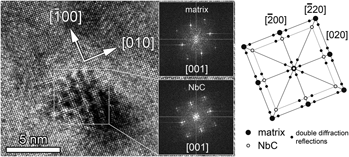Crossref Citations
This article has been cited by the following publications. This list is generated based on data provided by
Crossref.
Petráš, Roman
and
Polák, Jaroslav
2018.
Damage mechanism in austenitic steel during high temperature cyclic loading with dwells.
International Journal of Fatigue,
Vol. 113,
Issue. ,
p.
335.
Mazánová, V.
Heczko, M.
and
Polák, J.
2018.
Fatigue crack initiation and growth in 43Fe-25Ni-22.5Cr austenitic steel at a temperature of 700 °C.
International Journal of Fatigue,
Vol. 114,
Issue. ,
p.
11.
Heczko, M.
Esser, B.D.
Smith, T.M.
Beran, P.
Mazánová, V.
McComb, D.W.
Kruml, T.
Polák, J.
and
Mills, M.J.
2018.
Atomic resolution characterization of strengthening nanoparticles in a new high-temperature-capable 43Fe-25Ni-22.5Cr austenitic stainless steel.
Materials Science and Engineering: A,
Vol. 719,
Issue. ,
p.
49.
Xu, Lianyong
Yang, Shangqing
Zhao, Lei
Han, Yongdian
Jing, Hongyang
and
Wang, Kaimeng
2020.
Low cycle fatigue behavior and microstructure evolution of a novel Fe-22Cr-15Ni austenitic heat-resistant steel.
Journal of Materials Research and Technology,
Vol. 9,
Issue. 6,
p.
14388.
Li, Haizhou
Jing, Hongyang
Xu, Lianyong
Zhao, Lei
and
Han, Yongdian
2020.
Formation mechanism of M23C6 around NbCrN and its effect on fatigue behavior for a novel 25.5Ni-23.5Cr-3W-3Cu-1.5Co alloy.
Journal of Materials Research and Technology,
Vol. 9,
Issue. 5,
p.
9746.
Li, Bingbing
Zheng, Yiming
Liu, Caiming
Li, Qite
Zhang, Zhe
and
Chen, Xu
2020.
Torsional thermomechanical fatigue behavior of 316LN stainless steel.
Materials Science and Engineering: A,
Vol. 789,
Issue. ,
p.
139676.
Polák, Jaroslav
and
Petráš, Roman
2020.
Cyclic plastic response and damage mechanisms in superaustenitic steel Sanicro 25 in high temperature cycling – Effect of tensile dwells and thermomechanical cycling.
Theoretical and Applied Fracture Mechanics,
Vol. 108,
Issue. ,
p.
102641.
Li, Bingbing
Zheng, Yiming
Shi, Shouwen
Zhang, Zhe
and
Chen, Xu
2020.
Cyclic deformation and cracking behavior of 316LN stainless steel under thermomechanical and isothermal fatigue loadings.
Materials Science and Engineering: A,
Vol. 773,
Issue. ,
p.
138866.
Li, Haizhou
Jing, Hongyang
Xu, Lianyong
Han, Yongdian
Zhao, Lei
Yang, Shangqing
and
Tang, Zhengxin
2020.
Effect of strain rate induced M23C6 distribution on cyclic deformation behavior: Cyclic hardening model.
International Journal of Plasticity,
Vol. 127,
Issue. ,
p.
102634.
Kim, Jung Gi
Park, Jeong Min
Seol, Jae Bok
Choe, Jungho
Yu, Ji-Hun
Yang, Sangsun
and
Kim, Hyoung Seop
2020.
Nano-scale solute heterogeneities in the ultrastrong selectively laser melted carbon-doped CoCrFeMnNi alloy.
Materials Science and Engineering: A,
Vol. 773,
Issue. ,
p.
138726.
Wang, Huatian
Du, Huayun
Wei, Yinghui
Hou, Lifeng
Liu, Xiaoda
Wei, Huan
Liu, Baosheng
and
Jia, Jianwen
2021.
Precipitation and Properties at Elevated Temperature in Austenitic Heat‐Resistant Steels—A Review.
steel research international,
Vol. 92,
Issue. 2,
Yang, Sheng-Min
Wu, Jing-Lin
Pan, Yeong-Tsuen
and
Lin, Dong-Yih
2021.
Precipitate Evolution in 22Cr25NiWCuCo(Nb) Austenitic Heat-Resistant Stainless Steel during Heat Treatment at 1200 °C.
Materials,
Vol. 14,
Issue. 5,
p.
1104.
Yang, Shouxing
Li, Huabing
Feng, Hao
Li, Xuze
Jiang, Zhouhua
and
He, Tong
2021.
Nitrogen Solubility in Liquid Fe–Nb, Fe–Cr–Nb, Fe–Ni–Nb and Fe–Cr–Ni–Nb Alloys.
ISIJ International,
Vol. 61,
Issue. 5,
p.
1498.
Petráš, Roman
Šulák, Ivo
and
Polák, Jaroslav
2021.
The effect of dwell on thermomechanical fatigue in superaustenitic steel Sanicro 25.
Fatigue & Fracture of Engineering Materials & Structures,
Vol. 44,
Issue. 3,
p.
673.
Gao, Jianbing
Xu, Zhenlin
Fang, Xudong
He, Junjing
Li, Weihuo
Du, Xiaojie
He, Yizhu
Jia, Xiquan
and
Zhou, Shengxuan
2022.
Enhancing creep resistance of aged Fe–Cr–Ni medium-entropy alloy via nano-sized Cu-rich and NbC precipitates investigated by nanoindentation.
Journal of Materials Research and Technology,
Vol. 20,
Issue. ,
p.
1860.
Amirifard, M.
Zarei Hanzaki, A.
Abedi, H.R.
Eftekhari, N.
and
Wang, Q.
2022.
Toward superior fatigue and corrosion fatigue crack initiation resistance of Sanicro 28 pipe super austenitic stainless steel.
Journal of Materials Research and Technology,
Vol. 17,
Issue. ,
p.
1672.
Zhang, Shuzhan
Shi, Xianbo
Su, Yuanfei
Yan, Wei
Rong, Lijian
and
Yang, Ke
2023.
Stress Relaxation Behavior of a Nb-Stabilized Austenitic Stainless Steel at 550 ℃.
Acta Metallurgica Sinica (English Letters),
Vol. 36,
Issue. 12,
p.
2079.
Gao, Jianbing
Zhou, Hongwei
Shen, Jiaming
Wei, Hailian
Fang, Xudong
and
He, Yizhu
2024.
Effect of Mixed-Grain Structure on Low-Cycle Fatigue Behavior of Fe-22Cr-25Ni Austenitic Steel at Elevated Temperature.
Journal of Materials Engineering and Performance,
Vol. 33,
Issue. 1,
p.
496.
Polák, Jaroslav
and
Šulák, Ivo
2025.
Effective and internal stresses in cyclically strained materials.
Results in Engineering,
p.
103895.
Lee, Sukjin
Seo, Eun Jung
Matlock, D. K.
Speer, John
and
Cryderman, Robert
2025.
Effects of (Al + N) and (Nb + Mo) Microalloying and Reduction Ratio of Cold Rolling on Abnormal Grain Growth in AISI 4121 Carburizing Steels.
Metallurgical and Materials Transactions A,
Vol. 56,
Issue. 1,
p.
180.
